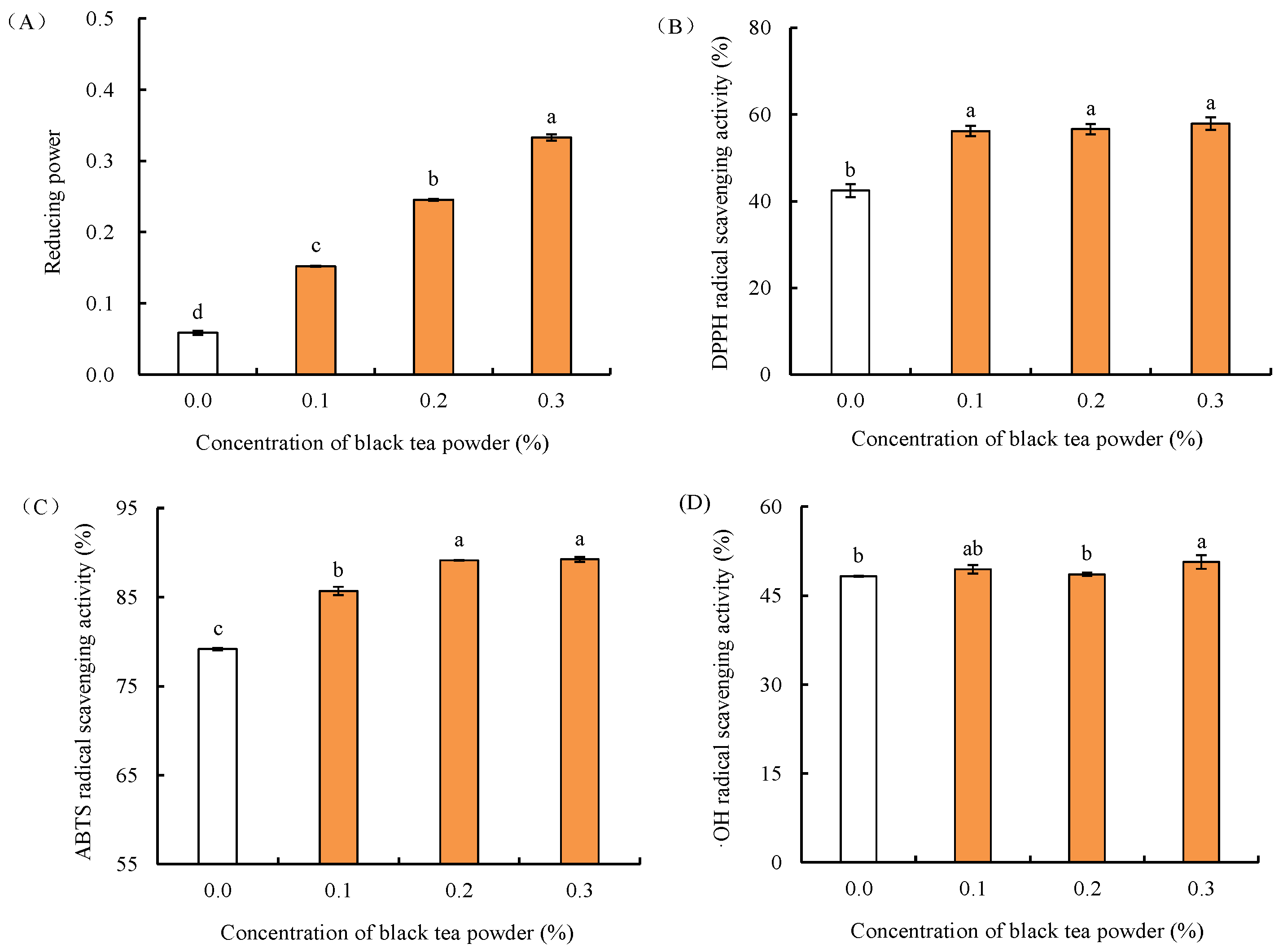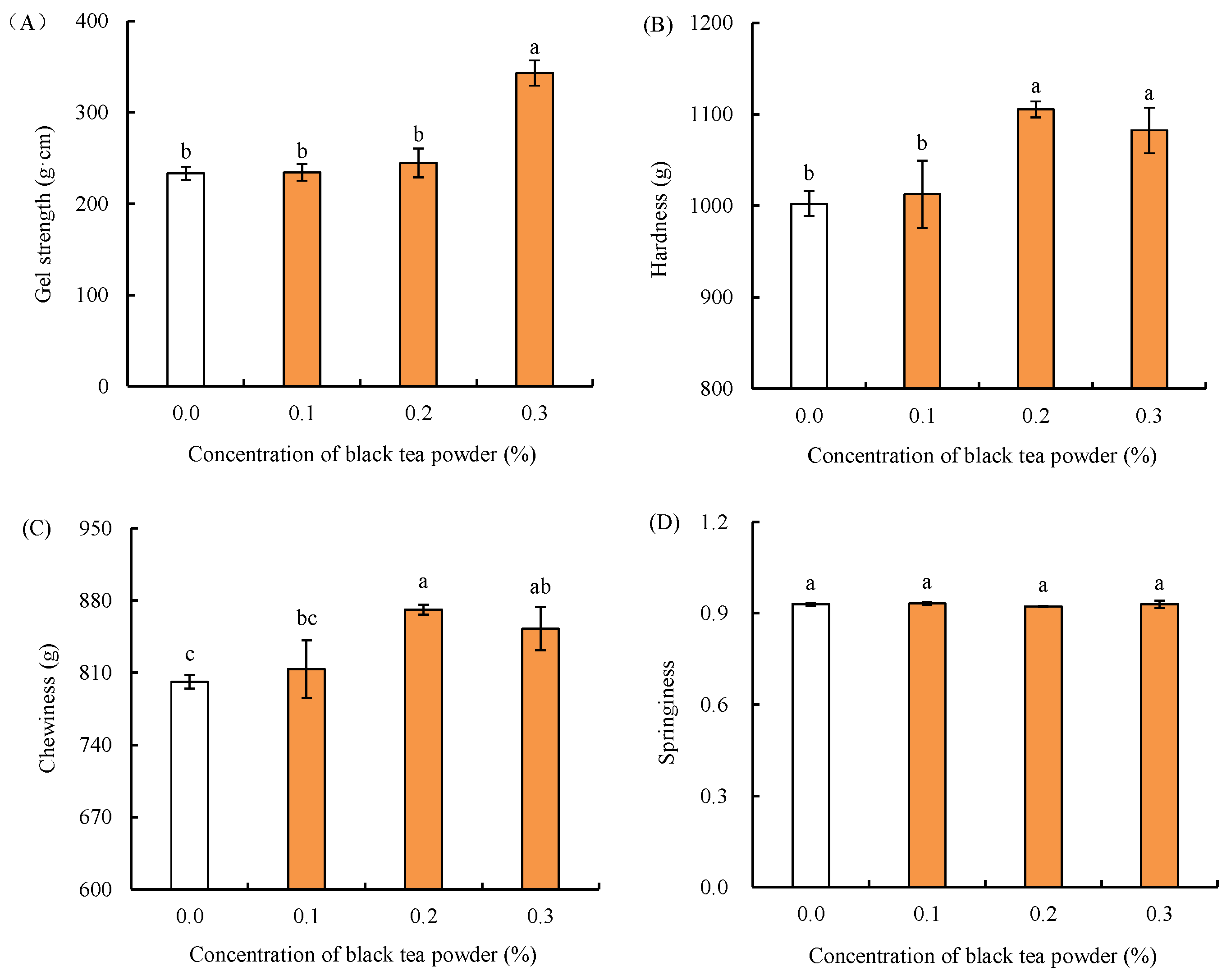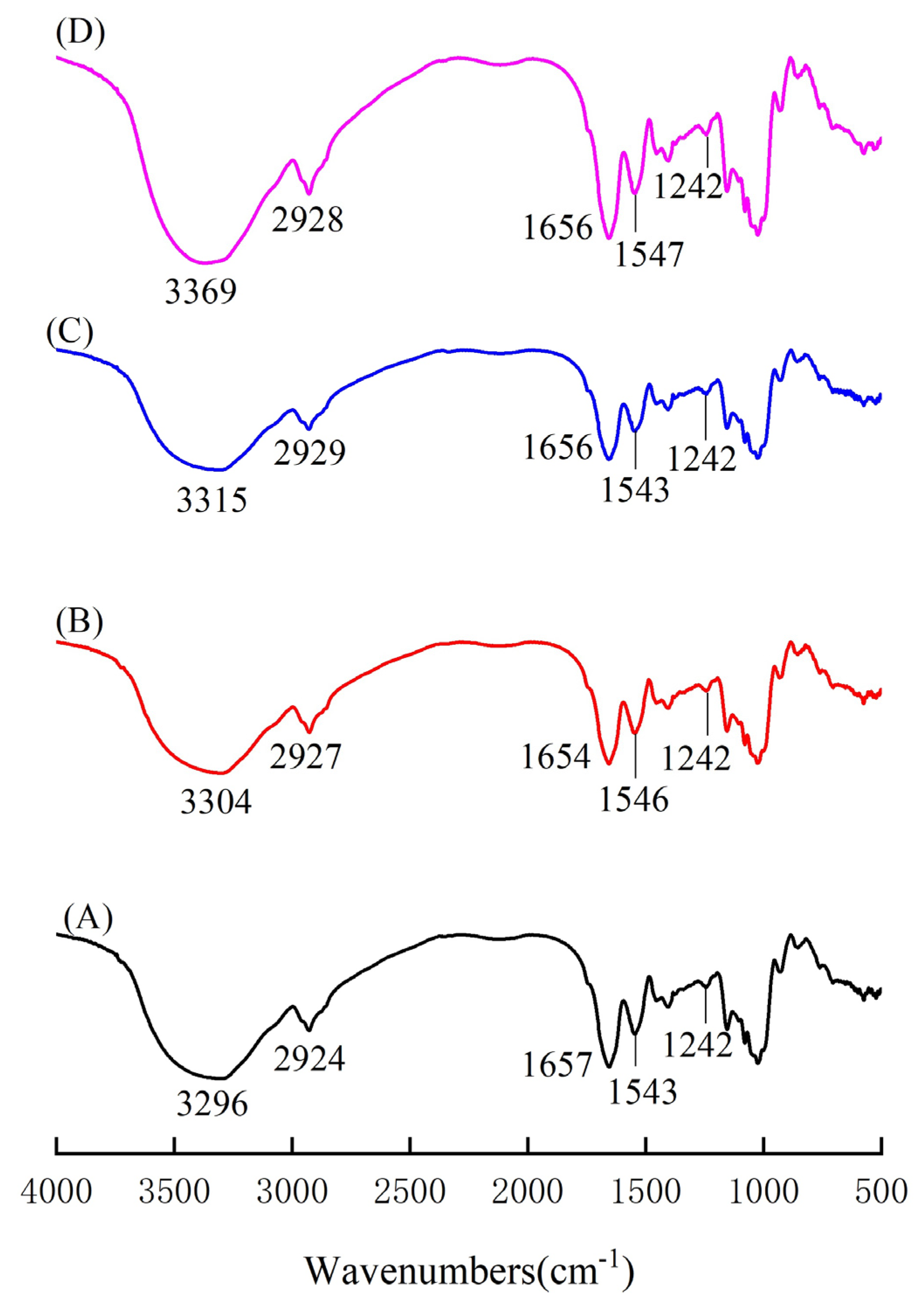Effect of Black Tea Powder on Antioxidant Activity and Gel Characteristics of Silver Carp Fish Balls
Abstract
1. Introduction
2. Results and Discussion
2.1. Effect of Black Tea Powder on Antioxidant Activity of Fish Balls
2.2. Effects of Black Tea Powder on Gel Properties of Fish Balls
2.3. Effects of Black Tea Powder on Color Properties of Fish Balls
2.4. Effects of Black Tea Powder on FT-IR of Fish Balls
2.5. Effect of Black Tea Powder on Microstructures of Fish Balls
2.6. Effect of Black Tea Powder on Sensory Evaluation of Fish Balls
3. Conclusions
4. Material and Methods
4.1. Materials
4.2. Preparation of Fish Balls
4.3. Antioxidant Activity Analysis
4.3.1. Reducing Capacity
4.3.2. DPPH Radical Scavenging Activity
4.3.3. ABTS Radical Scavenging Activity
4.3.4. OH Radical Scavenging Activity
4.4. Determination of Gel Strength
4.5. Determination of Texture Profile Analysis (TPA)
4.6. Determination of Color Properties
4.7. Fourier Transform Infrared (FT-IR) Spectroscopy Analysis
4.8. Gel Microstructure Analysis
4.9. Sensory Evaluation
4.10. Statistical Analysis
Author Contributions
Funding
Data Availability Statement
Conflicts of Interest
References
- Mi, H.; Li, Y.; Wang, C.; Yi, S.; Li, X.; Li, J. The interaction of starch-gums and their effect on gel properties and protein conformation of silver carp surimi. Food Hydrocoll. 2021, 112, 106290. [Google Scholar] [CrossRef]
- Cheng, J.; Xu, L.; Xiang, R.; Liu, X.; Zhu, M. Effects of mulberry polyphenols on oxidation stability of sarcoplasmic and myofibrillar proteins in dried minced pork slices during processing and storage. Meat Sci. 2020, 160, 107973. [Google Scholar] [CrossRef] [PubMed]
- Sun, W.; Zhou, F.; Zhao, M.; Yang, B.; Cui, C. Physicochemical changes of myofibrillar proteins during processing of Cantonese sausage in relation to their aggregation behaviour and in vitro digestibility. Food Chem. 2011, 129, 472–478. [Google Scholar] [CrossRef]
- Zheng, M.; Liu, X.; Chuai, P.; Jiang, Z.; Zhu, Y.; Zhang, B.; Ni, H.; Li, Q. Effects of crude fucoidan on physicochemical properties, antioxidation and bacteriostasis of surimi products. Food Control 2021, 122, 107806. [Google Scholar] [CrossRef]
- Roy, V.C.; Chamika, W.A.S.; Park, J.S.; Ho, T.C.; Khan, F.; Kim, Y.M.; Chun, B.S. Preparation of bio-functional surimi gel incorporation of fish oil and green tea extracts: Physio-chemical activities, in-vitro digestibility, and bacteriostatic properties. Food Control 2021, 130, 108402. [Google Scholar] [CrossRef]
- Nirmala, C.; Bisht, M.S.; Bajwa, H.K.; Santosh, O. Bamboo: A rich source of natural antioxidants and its applications in the food and pharmaceutical industry. Trends Food Sci. Technol. 2018, 77, 91–99. [Google Scholar] [CrossRef]
- Rajapaksha, S.; Shimizu, N. Pilot-scale extraction of polyphenols from spent black tea by semi-continuous subcritical solvent extraction. Food Chem. X 2022, 13, 100200. [Google Scholar] [CrossRef]
- Jeong, C.H.; Ryu, H.; Zhang, T.; Lee, C.H.; Seo, H.G.; Han, S.G. Green tea powder supplementation enhances fermentation and antioxidant activity of set-type yogurt. Food Sci. Biotech. 2018, 27, 1419–1427. [Google Scholar] [CrossRef]
- Zhang, H.; Qi, R.; Mine, Y. The impact of oolong and black tea polyphenols on human health. Food Biosci. 2019, 29, 55–61. [Google Scholar] [CrossRef]
- Yang, Z.; Tu, Y.; Xia, H.; Jie, G.; Chen, X.; He, P. Suppression of free-radicals and protection against H2O2-induced oxidative damage in HPF-1 cell by oxidized phenolic compounds present in black tea. Food Chem. 2007, 105, 1349–1356. [Google Scholar] [CrossRef]
- Jaziri, I.; Slama, M.B.; Mhadhbi, H.; Urdaci, M.C.; Hamdi, M. Effect of green and black teas (Camellia sinensis L.) on the characteristic microflora of yogurt during fermentation and refrigerated storage. Food Chem. 2009, 112, 614–620. [Google Scholar] [CrossRef]
- Cardoso, R.R.; Neto, R.O.; D’Almeida, C.T.D.S.; Nascimento, T.P.D.; Pressete, C.G.; Azevedo, L.; Martino, H.S.D.; Cameron, L.C.; Ferreira, M.S.L.; Barros, F.A.R.D. Kombuchas from green and black teas have different phenolic profile, which impacts their antioxidant capacities, antibacterial and antiproliferative activities. Food Res. Int. 2020, 128, 108782. [Google Scholar] [CrossRef] [PubMed]
- Xue, H.; Xu, M.; Liao, M.; Luo, W.; Zhang, G.; Tu, Y.; Zhao, Y. Effects of tea and illicium verum braise on physicochemical charac- teristics, microstructure, and molecular structure of heat-induced egg white protein gel. Food Hydrocoll. 2021, 110, 106181. [Google Scholar] [CrossRef]
- Zhu, J.; You, Y.; Shuai, X.; Chen, D. Effects of different varieties of tea on the processing quality of marinated egg. China Condiment 2019, 44, 80–99. (In Chinese) [Google Scholar]
- Wiriyaphan, C.; Chitsomboon, B.; Yongsawadigul, J. Antioxidant activity of protein hydrolysates derived from threadfin bream surimi byproducts. Food Chem. 2012, 132, 104–111. [Google Scholar] [CrossRef]
- Ita, B.N.; Eduok, S.I. In vitro antioxidant and antifungal activities of Rhizophora racemosa G.F.W. Mey. stem bark extracts. Sci. Afr. 2022, 15, e01091. [Google Scholar] [CrossRef]
- Yin, D.; Sun, X.; Li, N.; Guo, Y.; Tian, Y.; Wang, L. Structural properties and antioxidant activity of polysaccharides extracted from Laminaria japonica using various methods. Process. Biochem. 2021, 111, 201–209. [Google Scholar] [CrossRef]
- Deng, Q.; Wang, W.; Zhang, Q.; Chen, J.; Zhou, H.; Meng, W.; Li, J. Extraction optimization of polysaccharides from Gougunao tea and assessment of the antioxidant and hypoglycemic activities of its fractions in vitro. Bioact. Carbohydr. Diet. Fibre 2021, 26, 100287. [Google Scholar] [CrossRef]
- Floegel, A.; Kim, D.O.; Chung, S.J.; Koo, S.I.; Chun, O.K. Comparison of ABTS/DPPH assays to measure antioxidant capacity in popular antioxidant-rich US foods. J. Food Compos. Anal. 2011, 24, 1043–1048. [Google Scholar] [CrossRef]
- Ren, Y.; Liu, H.; Wang, D.; Liu, T.; Zhang, R.; Wu, Y.; Zhang, Y.; Han, J.; Liu, M. Antioxidant activity, stability, in vitro digestion and cytotoxicity of two dietary polyphenols co-loaded by β-lactoglobulin. Food Chem. 2022, 371, 131385. [Google Scholar] [CrossRef]
- Wu, Y.T.; Huo, Y.F.; Xu, L.; Xu, Y.Y.; Wang, X.L.; Zhou, T. Purification, characterization and antioxidant activity of polysaccharides from Porphyra haitanensis. Int. J. Biol. Macromol. 2020, 165, 2116–2125. [Google Scholar] [CrossRef]
- Chen, J.; Huang, G. Antioxidant activities of garlic polysaccharide and its phosphorylated derivative. Int. J. Biol. Macromol. 2019, 125, 432–435. [Google Scholar] [CrossRef]
- Amirdivani, S.; Baba, A.S.H. Green tea yogurt: Major phenolic compounds and microbial growth. J. Food Sci. Technol. 2015, 52, 4652–4660. [Google Scholar] [CrossRef]
- Tu, F.; Xie, C.; Li, H.; Lei, S.; Li, J.; Huang, X.; Yang, F. Effect of in vitro digestion on chestnut outer-skin and inner-skin bioaccessibility: The relationship between biotransformation and antioxidant activity of polyphenols by metabolomics. Food Chem. 2021, 363, 130277. [Google Scholar] [CrossRef] [PubMed]
- Park, D.; Xiong, Y.; Alderton, A.L. Concentration effects of hydroxyl radical oxidizing systems on biochemical properties of porcine muscle myofibrillar protein. Food Chem. 2007, 101, 1239–1246. [Google Scholar] [CrossRef]
- Huang, X.; Sun, L.; Dong, K.; Wang, G.; Luo, P.; Tang, D.; Huang, Q. Mulberry fruit powder enhanced the antioxidant capacity and gel properties of hammered minced beef: Oxidation degree, rheological, and structure. LWT 2022, 154, 112648. [Google Scholar] [CrossRef]
- Shitole, S.S.; Balange, A.K.; Gangan, S.S. Use of seaweed (Sargassum tenerrimum) extract as gel enhancer for lesser sardine (Sardinella brachiosoma) surimi. Int. Aquat. Res. 2014, 6, 55. [Google Scholar] [CrossRef]
- Chanarat, S.; Benjakul, S.; Xiong, Y. Nonprotein Nitrogenous Compounds and Gelling Property of Whitecheek Shark (Carcharhinus dussumieri) Mince as Affected by Washing and Microbial Transglutaminase. J. Texture Stud. 2014, 45, 307–316. [Google Scholar] [CrossRef]
- Duangmal, K.; Taluengphol, A. Effect of protein additives, sodium ascorbate, and microbial transglutaminase on the texture and colour of red tilapia surimi gel. Int. J. Food Sci. Technol. 2010, 45, 48–55. [Google Scholar] [CrossRef]
- Singh, A.; Benjakul, S. Serine protease inhibitors from squid ovary: Extraction and its effect on proteolysis and gel properties of surimi. J. Food Sci. Technol. 2017, 54, 267–275. [Google Scholar] [CrossRef]
- Zhou, X.; Chen, T.; Lin, H.; Chen, H.; Liu, J.; Lv, F.; Ding, Y. Physicochemical properties and microstructure of surimi treated with egg white modified by tea polyphenols. Food Hydrocoll. 2019, 90, 82–89. [Google Scholar] [CrossRef]
- Fang, Q.; Shi, L.; Ren, Z.; Hao, G.; Chen, J.; Weng, W. Effects of emulsified lard and TGase on gel properties of threadfin bream (Nemipterus virgatus) surimi. LWT 2021, 146, 111513. [Google Scholar] [CrossRef]
- Ge, L.; Zhu, M.; Li, X.; Xu, Y.; Ma, X.; Shi, R.; Li, D.; Mu, C. Development of active rosmarinic acid-gelatin biodegradable films with antioxidant and long-term antibacterial activities. Food Hydrocoll. 2018, 83, 308–316. [Google Scholar] [CrossRef]
- Guan, A.; Mei, K.; Lv, M.; Lu, J.; Lou, Q.; Yang, W. The effect of electron beam irradiation on IgG binding capacity and conformation of tropomyosin in shrimp. Food Chem. 2018, 264, 250–254. [Google Scholar] [CrossRef]
- Dou, L.; Li, B.; Zhang, K.; Chu, X.; Hou, H. Physical properties and antioxidant activity of gelatinsodium alginate edible films with tea polyphenol. Int. J. Biol. Macromol. 2018, 118, 1377–1383. [Google Scholar] [CrossRef]
- Ho, T.C.; Kim, M.H.; Cho, Y.J.; Park, J.S.; Nam, S.Y.; Chun, B.S. Gelatin-sodium alginate based films with Pseuderanthemum palatiferum (Nees) Radlk. freeze-dried powder obtained by subcritical water extraction. Food Packag. Shelf Life 2020, 24, 100469. [Google Scholar] [CrossRef]
- Zhou, Y.; Dai, H.; Ma, L.; Yu, Y.; Zhu, H.; Wang, H.; Zhang, Y. Effect and mechanism of psyllium husk (Plantago ovata) on myofibrillar protein gelation. LWT 2021, 138, 110651. [Google Scholar] [CrossRef]
- Weng, W.; Zheng, W. Silver Carp (Hypophthalmichthys molitrix) Surimi Acid-Induced Gel Extract Characteristics: A Comparison with Heat-Induced Gel. Int. J. Food Prop. 2015, 18, 821–832. [Google Scholar] [CrossRef]
- Du, H.; Wang, X.; Yang, H.; Zhu, F.; Tang, D.; Cheng, J.; Liu, X. Changes of phenolic profile and antioxidant activity during cold storage of functional flavored yogurt supplemented with mulberry pomace. Food Control 2022, 132, 108554. [Google Scholar] [CrossRef]
- Liang, Q.; Sun, X.; Raza, H.; Khan, M.A.; Ma, H.; Ren, X. Fabrication and characterization of quercetin loaded casein phosphopeptides-chitosan composite nanoparticles by ultrasound treatment: Factor optimization, formation mechanism, physicochemical stability and antioxidant activity. Ultrason. Sonochem. 2021, 80, 105830. [Google Scholar] [CrossRef]
- Yan, W.; Yin, T.; Xiong, S.; You, J.; Hu, Y.; Huang, Q. Gelling properties of silver carp surimi incorporated with konjac glucomannan: Effects of deacetylation degree. Int. J. Biol. Macromol. 2021, 191, 925–933. [Google Scholar] [CrossRef] [PubMed]
- Li, D.Y.; Tan, Z.F.; Liu, Z.Q.; Wu, C.; Liu, H.L.; Guo, C.; Zhou, D.Y. Effect of hydroxyl radical induced oxidation on the physicochemical and gelling properties of shrimp myofibrillar protein and its mechanism. Food Chem. 2021, 351, 129344. [Google Scholar] [CrossRef] [PubMed]
- Piao, X.; Huang, J.; Sun, Y.; Zhao, Y.; Zheng, B.; Zhou, Y.; Yu, H.; Zhou, R.; Cullen, P.J. Inulin for surimi gel fortification: Performance and molecular weight-dependent effects. Carbohyd. Polym. 2023, 305, 120550. [Google Scholar] [CrossRef]
- Luo, X.; Xiao, S.; Ruan, Q.; Gao, Q.; An, Y.; Hu, Y.; Xiong, S. Differences in flavor characteristics of frozen surimi products reheated by microwave, water boiling, steaming, and frying. Food Chem. 2022, 372, 131260. [Google Scholar] [CrossRef] [PubMed]




| Concentration/% | L* | a* | b* | Whiteness |
|---|---|---|---|---|
| 0.0 | 61.00 ± 0.39 a | 0.58 ± 0.28 d | 4.67 ± 0.16 d | 60.72 ± 0.41 a |
| 0.1 | 53.30 ± 0.67 b | 6.78 ± 0.21 c | 7.77 ± 0.16 c | 52.17 ± 0.66 b |
| 0.2 | 49.00 ± 0.41 c | 10.88 ± 0.55 b | 9.86 ± 0.35 b | 46.93 ± 0.46 c |
| 0.3 | 45.72 ± 0.54 d | 14.83 ± 0.45 a | 10.68 ± 0.51 a | 42.72 ± 0.46 d |
| Project | 0.0% | 0.1% | 0.2% | 0.3% |
|---|---|---|---|---|
| Color | 9.25 ± 0.43 a | 7.25 ± 0.43 b | 5.88 ± 0.78 c | 4.50 ± 1.32 d |
| Odor | 5.50 ± 1.12 b | 7.06 ± 1.24 ab | 6.63 ± 1.65 ab | 7.38 ± 1.49 a |
| Tissue | 6.75 ± 1.48 a | 7.13 ± 1.17 a | 6.63 ± 1.11 a | 5.88 ± 1.54 a |
| Springiness | 8.38 ± 0.99 a | 8.63 ± 0.86 a | 7.88 ± 1.27 a | 8.25 ± 0.83 a |
| Taste | 6.25 ± 1.09 b | 7.50 ± 1.32 ab | 7.19 ± 1.46 ab | 7.88 ± 1.27 a |
| Fondness | 6.00 ± 1.00 b | 7.13 ± 1.54 ab | 7.25 ± 1.48 ab | 7.88 ± 0.60 a |
| Project | Standard Description | Score |
|---|---|---|
| Color | Reddish brown, with no gloss | 0~4 |
| Yellowish brown, the gloss is slightly darker | 5~6 | |
| Light brown, relatively shiny | 7~8 | |
| Gray, shiny | 9~10 | |
| Odor | Strongly fishy | 0~4 |
| Obviously fishy | 5~6 | |
| Slightly fishy | 7~8 | |
| Not fishy | 9~10 | |
| Tissue | Internal structure with loose and larger pores | 0~4 |
| Loose internal structure with many small pores, and uniform | 5~6 | |
| Compact internal structure, with tiny and uniform small pores | 7~8 | |
| Compact internal structure, without small pores | 9~10 | |
| Springiness | Cracks when pressed | 0~4 |
| Does not crack after pressing and cannot be completely restored to its original shape after press removal | 5~6 | |
| Does not crack after pressing and cannot rapidly recover after press removal | 7~8 | |
| Does not crack after pressing and can rapidly recover after press removal | 9~10 | |
| Taste | No fish taste and rough chew | 0~4 |
| Less fish taste and slightly rough chew | 5~6 | |
| With fish taste and tea taste, slightly delicate and smooth | 7~8 | |
| With fish taste and tea taste, delicate and smooth | 9~10 | |
| Fondness | Don’t like | 0~4 |
| General | 5~6 | |
| Prefer | 7~8 | |
| Like very much | 9~10 |
Disclaimer/Publisher’s Note: The statements, opinions and data contained in all publications are solely those of the individual author(s) and contributor(s) and not of MDPI and/or the editor(s). MDPI and/or the editor(s) disclaim responsibility for any injury to people or property resulting from any ideas, methods, instructions or products referred to in the content. |
© 2023 by the authors. Licensee MDPI, Basel, Switzerland. This article is an open access article distributed under the terms and conditions of the Creative Commons Attribution (CC BY) license (https://creativecommons.org/licenses/by/4.0/).
Share and Cite
Hong, J.; Wu, J.; Chen, Y.; Jiang, Z.; Zhu, Y.; Li, Z.; Chen, X.; Ni, H.; Zheng, M. Effect of Black Tea Powder on Antioxidant Activity and Gel Characteristics of Silver Carp Fish Balls. Gels 2023, 9, 215. https://doi.org/10.3390/gels9030215
Hong J, Wu J, Chen Y, Jiang Z, Zhu Y, Li Z, Chen X, Ni H, Zheng M. Effect of Black Tea Powder on Antioxidant Activity and Gel Characteristics of Silver Carp Fish Balls. Gels. 2023; 9(3):215. https://doi.org/10.3390/gels9030215
Chicago/Turabian StyleHong, Jinling, Jiaying Wu, Yanhong Chen, Zedong Jiang, Yanbing Zhu, Zhipeng Li, Xianmu Chen, Hui Ni, and Mingjing Zheng. 2023. "Effect of Black Tea Powder on Antioxidant Activity and Gel Characteristics of Silver Carp Fish Balls" Gels 9, no. 3: 215. https://doi.org/10.3390/gels9030215
APA StyleHong, J., Wu, J., Chen, Y., Jiang, Z., Zhu, Y., Li, Z., Chen, X., Ni, H., & Zheng, M. (2023). Effect of Black Tea Powder on Antioxidant Activity and Gel Characteristics of Silver Carp Fish Balls. Gels, 9(3), 215. https://doi.org/10.3390/gels9030215








